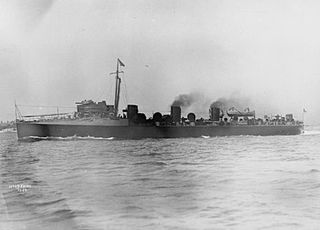Construction and design
Kangaroo was laid down by Palmers Shipbuilding and Iron Company at Jarrow-on-Tyne as Yard Number 787 on 29 December 1899 with work starting on speculation (i.e. without a specific order), but was purchased for the Royal Navy as part of the 1900–1901 shipbuilding programme. She was launched on 8 September 1900 and completed in July 1901. [6]
Kangaroo was of similar design to HMS Peterel, Myrmidon and Syren, three "Thirty-Knotter" destroyers built by Palmers under the 1899–1900 programme. Like these ships, she was powered by triple-expansion steam engines fed by four Reed boilers and driving two propeller shafts. Four funnels were fitted, with the two middle funnels very closely spaced. The machinery was rated at 6,200 indicated horsepower (4,600 kW), sufficient to propel the ship at her contract speed of 30 knots (56 km/h; 35 mph). [7]
Gun armament consisted of a single QF 12-pounder 12 cwt (3 in (76 mm) calibre) gun forward on a platform on the ship's conning tower together with five 6-pounder guns. Two 18-inch (450 mm) torpedo tubes completed the ship's armament. [8] [9]
HMS Electra was a Clydebank-built, three-funnelled, 30-knot destroyer ordered by the Royal Navy under the 1895–1896 Naval Estimates. She was the fourth ship to carry this name since it was introduced in 1806 for a 16-gun brig-sloop.
HMS Wolf was a B-class torpedo boat destroyer of the British Royal Navy. She was completed by Laird, Son & Company, Birkenhead, in 1897.
HMS Seal was a B-class torpedo boat destroyer of the British Royal Navy. She was completed by Laird, Son & Company, Birkenhead, in 1897.
HMS Panther was a B-class torpedo boat destroyer of the British Royal Navy. She was completed by Laird, Son & Company, Birkenhead, in 1897.
HMS Locust was a B-class torpedo boat destroyer of the British Royal Navy. She was launched by Laird, Son & Company, Birkenhead, on 5 December 1896. She served in the Mediterranean between 1902 and 1906, and was used for patrol and escort duties during the First World War
HMS Orwell was a B-class torpedo boat destroyer of the British Royal Navy. She was built by Laird, Son & Company, and served from 1900 until 1920.
HMS Success was a B-class torpedo boat destroyer of the Royal Navy. She was launched on 21 March 1901. On 27 December 1914 she was wrecked off Fife Ness during heavy gales.
HMS Boxer was an Ardent-class destroyer which served with the Royal Navy, launched on 28 November 1894. She spent several years operating with the Mediterranean Fleet and remained active during the First World War. She was sunk in a collision on 8 February 1918.
HMS Myrmidon was one of two Myrmidon-class destroyers which served with the Royal Navy.
HMS Star was a Palmer three-funnel, 30-knot destroyer ordered by the Royal Navy under the 1896–1897 Naval Estimates. She was the eleventh ship to carry this name since it was introduced in 1643 for a 19-gun ship sold until 1652.

HMS Mermaid was a Hawthorn Leslie three-funnel, 30 knot destroyer ordered by the Royal Navy under the 1896 – 1897 Naval Estimates. She was launched in 1898, served during World War I and was sold for breaking in 1919.

HMS Racehorse was a three-funnel, 30-knot torpedo boat destroyer built by Hawthorn Leslie for the Royal Navy. Ordered by the Royal Navy under the 1898–1899 Naval Estimates, she was the eighth ship to carry this name since it was introduced in 1757. She served in World War I and was sold for breaking in 1920.

HMS Roebuck was a Hawthorn Leslie three-funnel, 30-knot destroyer ordered by the Royal Navy under the 1898–1899 Naval Estimates. She was the twelfth ship to carry the name. She served during World War I and was broken up in 1919.

HMS Gipsy was a Fairfield-built three-funnel, 30 knot torpedo boat destroyer ordered by the Royal Navy under the 1896 – 1897 Naval Estimates. She was the fourth ship to carry this name. Designated as a C-class destroyer in 1913, Gipsy served on patrol in the First World War operating out of Dover. She was sold for breaking in 1921.

HMS Dove was a three funnel, 30 knot destroyer ordered by the Royal Navy under the 1896–1897 Naval Estimates. She was the ninth ship to carry the name.
HMS Leven was a Fairfield "30-knotter" destroyer of the Royal Navy, later classified as part of the C class. It was built in 1898–1899, and served with the Royal Navy through to the First World War, sinking a German U-boat in 1918. Leven was sold for scrapping in 1920.

HMS Mallard was a two funnel, 30-knot destroyer ordered by the Royal Navy under the 1894 – 1895 Naval Estimates. She served in Home waters both before and during the First World War, and was sold for breaking in 1920.

HMS Angler was a two-funnel, 30-knot destroyer ordered by the Royal Navy under the 1895 – 1896 Naval Estimates. She was the second ship to carry this name. She was launched in 1897, served at Chatham and Portsmouth and was sold for breaking in 1920.

HMS Fawn was a Palmer three funnel, 30 knot destroyer ordered by the Royal Navy under the 1896 – 1897 Naval Estimates. She was the fourth ship to carry this name.

HMS Falcon was a Fairfield three-funnel, 30 knot destroyer ordered by the Royal Navy under the 1898 – 1899 Naval Estimates. She spent her life in Home waters, was part of the Dover Patrol during World War I and was lost in a collision on 1 April 1918.
This page is based on this
Wikipedia article Text is available under the
CC BY-SA 4.0 license; additional terms may apply.
Images, videos and audio are available under their respective licenses.







